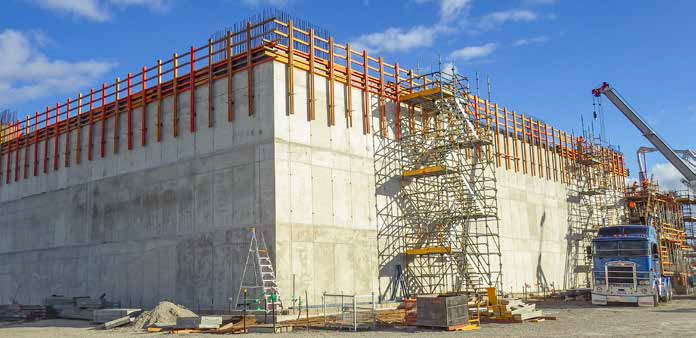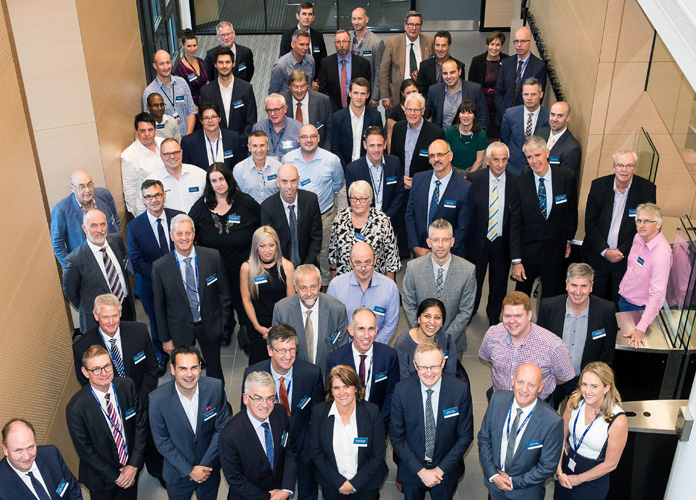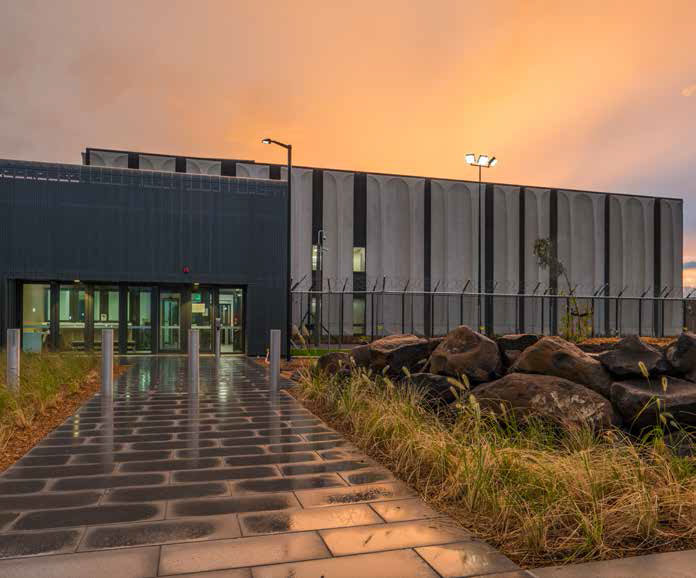Reserve Bank of Australia Annual Report – 2017 Management of the Reserve Bank
Much of the Reserve Bank's call on resources comes from ongoing activities associated with its key policy and operational responsibilities. A number of ongoing major projects, designed to strengthen its operations, have added to the Bank's costs in recent years. Several of these were brought to completion in 2016/17 and, as the remainder are completed in coming years, project costs are expected to return to historical levels.
The Reserve Bank's Costs
Project-related costs remained high by historical standards in 2016/17, as the effort to successfully deliver the program of major strategic projects continued. However, expenditure on projects is expected to fall from around mid 2017 as this portfolio is progressively completed. Costs associated with the Reserve Bank's ongoing activities rose largely as a result of new support activities associated with completed projects adding to existing costs.
The portfolio of projects largely comprises initiatives to support the continued effectiveness of the Reserve Bank's policy and central banking operations. Many of these projects are technology intensive and their completion will strengthen Australia's financial infrastructure. In 2016/17, some projects that had begun in previous years were completed while substantial progress was made on the delivery of others. The portfolio of projects generally remains within budget and on schedule.
Project work relating to banknote production and distribution continues to be an important area of focus. Associated with the introduction of the new series of banknotes is a range of related projects that focuses on logistics. Each element of this is now well advanced. The construction of the new banknote storage facility, the National Banknote Site (NBS) at Craigieburn in Victoria, was completed in March 2017. The NBS is highly secure and custom built for the storage, processing and distribution of banknotes. This project, which was approved by the Parliamentary Public Works Committee in February 2014, involved complex design, engineering and construction challenges related to security, operational and safety requirements. Final commissioning of the new facility is under way and the building is expected to be fully operational by early 2018. It will expand the current capacity of banknote storage and processing to accommodate operations associated with the issue of the new series of banknotes. The NBS will also accommodate machinery for validating and destroying banknotes that are returned from circulation, with the capacity to process both current and new banknote series. Costs associated with operating the NBS will be partially offset as the vault in the Reserve Bank's Melbourne CBD building ceases to be used.



The Reserve Bank continues to participate in the industry-led initiative to develop the New Payments Platform (NPP), which will allow low-value payments to be cleared and settled in near real time. The project is nearing completion to develop system-wide infrastructure for platforms that clear and settle transactions of authorised deposit-taking institutions resulting from low-value payments. The infrastructure for the Reserve Bank Information and Transfer System (RITS), which is Australia's high-value payments system, is also being strengthened as hardware is replaced within a more resilient and secure network structure, thereby further reducing risk in the interbank payments system. The ongoing operating costs of these banking and payments systems will, over time, be recovered from user fees. The Bank is also adapting its own banking systems so that its customers will be able to participate in the NPP, which is expected to commence operations around the end of 2017.
A number of projects were delivered in 2016/17 that will support the Reserve Bank's operations in financial markets. The Bank completed development on the Securitisations System, which facilitates more precise valuation of securitised instruments that may be used as collateral in the Bank's open market operations, strengthens associated risk management and houses data that will enable further research into securitised markets. The two-year project to upgrade the Bank's Treasury Management system was also successfully completed.
The outsourcing of the Reserve Bank staff superannuation fund was completed in March 2017. This will significantly reduce costs for both the Bank and fund members, and places the control and operation of this fund fully at arm's length from the Bank. (See the chapter on ‘Our People’ for further detail.)
Many of the Reserve Bank's activities and projects depend heavily on information technology (IT) systems and infrastructure. The Bank continues to pursue fit-for-purpose strategies to ensure IT assets are appropriately innovative, mature and resilient, and manage operational risk to acceptable levels. Significant resources have been applied to strengthening cyber security in recent years. The Bank has been certified as complying to a mature standard with the ‘Top 35’ strategies recommended by the Australian Signals Directorate (ASD) for containing cyber threats and will build on this as newer ASD strategies and standards evolve. The Bank has also attained certification of its internet gateway to the ISO 27001 global standard for Information Security Management.
The Reserve Bank has an ongoing program of investment to maintain the value of its physical assets, including buildings, to ensure that building services remain effective and resilient and that associated risks are managed appropriately. In 2016/17, there were a number of works at the Bank's Head Office in Martin Place in Sydney, including the installation of security bollards to strengthen perimeter security, upgrading the fire detection system and a mechanical upgrade of the passenger lifts.
General operating costs associated with running the Reserve Bank, as opposed to those associated with holding assets, making transactions or purchasing banknotes, rose by 11.0 per cent in 2016/17, with operating costs for ongoing activities, excluding depreciation and spending on projects, increasing by 4.6 per cent. The marked rise in non-staff costs largely reflected project-based activity and was related to the start-up of the NBS, new IT equipment for large projects, costs associated with the new banknote series and depreciation.
| 2012/13 | 2013/14(b) | 2014/15 | 2015/16 | 2016/17 | |
|---|---|---|---|---|---|
| Staff costs | 169.0 | 184.6 | 195.3 | 212.8 | 216.3 |
| Other costs | 76.8 | 87.9 | 89.0 | 97.4 | 128.0 |
| General operating costs | 245.8 | 272.5 | 284.3 | 310.3 | 344.3 |
| General operating costs (excluding depreciation) | 227.0 | 250.6 | 261.0 | 284.7 | 305.9 |
| Of which: Cost of projects |
11.8 | 18.4 | 28.0 | 34.9 | 44.8 |
|
(a) Excluding NPA and banknote management expenses, and costs directly linked
with transaction-based revenue Source: RBA |
|||||
| 2012/13 | 2013/14 | 2014/15 | 2015/16 | 2016/17 | |
|---|---|---|---|---|---|
| Capital costs | 29.8 | 44.2 | 56.5 | 108.1 | 100.7 |
| Of which: Cost of major projects(b) |
7.8 | 18.6 | 42.9 | 92.8 | 85.8 |
|
(a) Excluding NPA Source: RBA |
|||||
Operating costs for ongoing activities are expected to rise further in 2017/18, with a further appreciable rise in depreciation from the progressive delivery of capital initiatives, and new operating costs associated with the operation of the NBS and from the transfer of certain banknote operations staff from Note Printing Australia Limited (NPA). Excluding depreciation and the transfer of these staff, total operating costs are budgeted to rise by 2.5 per cent in 2017/18.
The extent of the Reserve Bank's investment in its strategic initiatives is reflected in capital expenditure over recent years. Capital outlays, which were about $101 million in 2016/17, were concentrated on completing the NBS and on the major initiatives to develop technology and communications systems for the Bank's banking, payments and settlements, and financial markets activities. Capital spending is expected to fall by about 30 per cent in 2017/18 and to decline further in subsequent years.
External Review of the Reserve Bank's Operations
During the year, the Reserve Bank commissioned an external review of its operations to help gain assurance that those operations were being conducted in a way that is both appropriate and makes effective use of public money. The review was chaired by David Tune AO, assisted by a team from Deloitte Consulting. The review provided assurance that the Bank's support services were functioning well in helping pursue the Bank's objectives. The review made observations on possible opportunities for improvement to support the Bank's aim to be continuously improving as an organisation. In addition to a number of smaller observations for improvement, the review had two major observations, which were:
- A range of workplace processes and transactional areas of the Bank could be centralised into a unified and expanded shared services centre. This would allow for an improved experience for staff, reduce the administrative burden and, over time, drive process improvements. This will require consideration of how the support service functions could be organised to support greater consistency in processes, technology and service delivery across functions and business activities.
- Following a successful transformation of the IT function over the preceding five years, which has enabled the Bank to deliver its significant project load, the time is now right for IT to transition to a steady-state size and structure, with a lower project load. The review also suggested a re-assessment of the support model such that the cost and effort associated with projects is reduced and the interaction between IT and the various user areas across the Bank is enhanced.
The Bank is in the process of following through on these observations.
Facilities and Environmental Management
The Reserve Bank owns premises in locations where there is a business need to do so. These facilities include the Head Office in Sydney; the HC Coombs Centre for Financial Studies in Kirribilli, Sydney; office buildings in Melbourne and Canberra; the note-printing facility and NBS at Craigieburn, north of Melbourne; and the Business Resumption Site in north-west Sydney. In addition to the buildings it owns, the Bank leases accommodation for its State Offices in Adelaide, Brisbane and Perth and for its offices in London, New York and Beijing. Independent valuers estimated that the value of the Bank's property assets increased by $134 million to about $524 million in 2016/17, reflecting the completion of the NBS and higher property prices in Sydney and Melbourne.
Accommodation in the Reserve Bank's properties that is not required for its own business purposes is leased to external tenants. Almost all of this surplus space is currently let to tenants. Net income from these leases amounted to $11.4 million in 2016/17, compared with $11.2 million in the previous year.
The Reserve Bank is committed to improving the environmental performance of its operations. The Bank has developed policies that are in accordance with the principles of ecologically sustainable development as set out in the Environment Protection and Biodiversity Conservation Act 1999. These policies work to reduce the impact of the Bank's operations on the environment and include initiatives to:
- reduce energy, water and paper consumption
- increase the recycling of paper, co-mingled waste and printing cartridges
- adopt environmentally sustainable designs for office fit-outs
- use 50/50 recycled paper
- use biodegradable takeaway coffee cups in the staff cafeteria
- increase the use of fuel-efficient vehicles.
Compared with averages over the preceding five years, electricity consumption of all Reserve Bank-operated sites increased by 4.4 per cent in 2016/17. This reflected production demand at the Craigieburn facility, with higher operating rates associated with printing the new series of banknotes and the commencement of operations at the NBS. Increased loads in the Bank's data centres as a result of new systems coming into operation also contributed to higher electricity consumption. Gas and water consumption in 2016/17 declined by 3.6 per cent and 1.2 per cent respectively compared with the previous year, as a result of improvements to the heating system and the domestic hot water system in Head Office and more efficient boiler operations at the Craigieburn facility and Canberra Branch.
Consultancies
The Reserve Bank employs outside contractors and professional service providers to carry out specific tasks where necessary and also, from time to time, uses consultants. Consultants are engaged where the Bank lacks specialist expertise or if independent research, review or assessment is required. Consultants are typically engaged to: investigate or diagnose a defined issue or problem; carry out defined reviews or evaluations; or provide independent advice or information to assist in the Bank's decision-making. Prior to engaging consultants, the Bank takes into account the skills and resources required for the task, the skills available internally, and the cost-effectiveness of engaging external expertise. Spending on consultancies over the past eight years is shown below.
| 2009/10 | 61,000 |
|---|---|
| 2010/11 | 102,000 |
| 2011/12 | 535,000 |
| 2012/13 | 1,190,000 |
| 2013/14 | 387,000 |
| 2014/15 | 773,000 |
| 2015/16 | 622,520 |
| 2016/17 | 987,388 |
|
(a) Sum of individual consultancies that cost $10,000 or more Source: RBA |
|
As in previous years, consultancies during 2016/17 covered a range of activities, with close to half of spending related to the external review of the Reserve Bank's operations commissioned by the Bank in early 2017; see the discussion earlier in this chapter for further detail. As in the previous year, there were also a number of consultancies related to the project to upgrade Australia's banknotes.